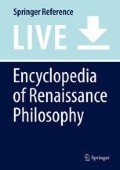Abstract
Renaissance advancements in light theory were grounded in innovative approaches to optics and ray theory by both scientists of the Arabic-speaking world as well as the great Scholastic philosophers who incorporated their discoveries into the edifice of Western proto-science. Heavenly lights – stars, planets, the sun, and virtually any body which transited the sky – were slowly evolving from religious phenomena to objects of natural philosophy. An arc can be followed from Classical and Neoplatonic philosophy to that of Medieval Arabic and Scholastic philosophy that increasingly views light (and other forms of radiation, whether or not they were visible), in newly material and predictable terms. These advancements in knowledge about the properties of light led to the development of new ways which humanity manipulated and interacted with light in the Renaissance.
References
Primary Literature
Al-Kindi. 1995. De radiis stellarum, eds. E. Albrile, and S. Fumagalli. Trans. E. Turri. Milano: Mimesis.
Aristotle. 1933–35. Metaphysics. Trans. Hugh Tredennick. New York: Putnam’s.
Bacon, Roger. 1928. Opus majus. Trans. R. B. Burke. 2 vols. New York: Russel and Russel.
Ficino, Marsilio. 1989. Three Books on Life [1489], ed. and Trans. Carol V. Kaske, and John R. Clark. Binghampton: Medieval and Renaissance Texts and Studies.
Kepler, Johannus. 1604. Ad Vitellionem Paralipomena, Quibus Astronomiae Pars Optica Traditur. Frankfurt: Claudium Marnium and Haeredes Joannis Aubrii.
Peckham, John, and C. Lindberg, Steven. 1970. John Pecham and the science of optics: Perspectiva communis. Madison: University of Wisconsin Press.
Secondary Literature
Ackerman, James S. 1980. On early renaissance color theory and practice. Memoirs of the American Academy in Rome 35: 11–44.
Bettini, Sergio. 2009. Shaping light: Practice and theory in renaissance architecture, Howard Hibbert Forum. New York: Columbia University.
Moshe, Barasch. 1978. Light and color in the Italian renaissance theory of art. New York: New York University Press.
Quinlan-McGrath, Mary. 2013. Influences: Art, optics, and astrology in the Italian renaissance. Chicago/London: Chicago University Press.
Author information
Authors and Affiliations
Corresponding author
Editor information
Editors and Affiliations
Section Editor information
Rights and permissions
Copyright information
© 2017 Springer International Publishing AG
About this entry
Cite this entry
Filson, L. (2017). Light Theory. In: Sgarbi, M. (eds) Encyclopedia of Renaissance Philosophy. Springer, Cham. https://doi.org/10.1007/978-3-319-02848-4_941-1
Download citation
DOI: https://doi.org/10.1007/978-3-319-02848-4_941-1
Received:
Accepted:
Published:
Publisher Name: Springer, Cham
Print ISBN: 978-3-319-02848-4
Online ISBN: 978-3-319-02848-4
eBook Packages: Springer Reference Religion and PhilosophyReference Module Humanities and Social SciencesReference Module Humanities

